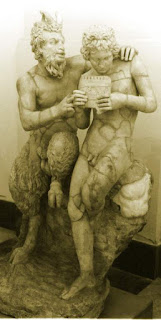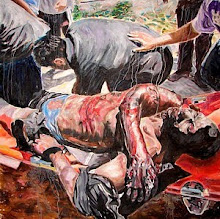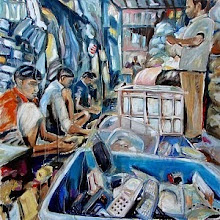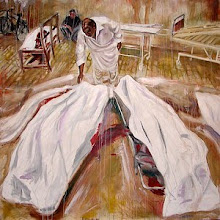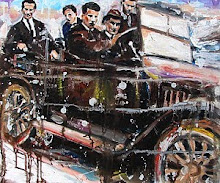Giorgio Vasari (1511-1574), Lives of the Artists.
The development and spread of Enlightenment ideas in the eighteenth century instituted new movements based on a scientific approach to the pursuit of happiness, sense evidence as the primary source of knowledge, and which believed in progress, liberty, constitutional government and separation of church and state. However, while the growth of Romanticism in the nineteenth century was a new movement emphasising the non-rational, or irrational, this was not new. Irrationalism stressed feeling, will and instinct over or against reason and its influence stretched back through time to the early Greeks. For example: "In ancient Greek culture—which is usually assessed as rationalistic — a Dionysian (i.e., instinctive) strain can be discerned in the works of the poet Pindar, in the dramatists, and even in such philosophers as Pythagoras and Empedocles and in Plato. In early modern philosophy — even during the ascendancy of Cartesian rationalism — Blaise Pascal turned from reason to an Augustinian faith, convinced that “the heart has its reasons” unknown to reason as such."
Here I will look at the relationship between science and irrationalism throughout history showing that at times rational investigation complemented irrational ideas, and at other times irrational ideas arose that conflicted with rational analysis. Early polytheistic society was less dogmatic in its attitude to science compared with Christian theology. Science slowly regained a foothold over the centuries and church ideology weakened. However, Romanticism took the place of the church as the main irrationalist ideology to hinder the growing influence of science in many different fields. Similarly with Christian ideology, it was the conservative elites who advanced and benefited from the irrationalist ideas of Romanticism, using the various offshoots of Romanticism (Nationalism, Modernism, Postmodernism, Metamodernism etc.) to try and hold back the progressive development of societies towards genuine democracy and freedom, the essential ideas that originated in the Enlightenment. However, as globalised hegemonic culture today becomes ever more saturated with Romanticism - in parallel with Romanticist political movements - there is a real fear that another wave of extreme irrationalist ideas and violence could be provoked and sweep the world within a short period of time.
Early religion and rational investigation
In early societies the irrational ideas of polytheistic religion were aided by rational investigation that helped with human understanding of nature, for example, the Mesopotamians studied scientific subjects, like astronomy, that helped with their religious system.
Astronomy was of utmost importance to some civilizations who left behind large artifacts (proto-observatories e.g. Newgrange in Ireland, Stonehenge in Great Britain, Angkor Wat in Cambodia, Abu Simbel in Egypt etc.) connected with the longest and shortest days of the year. This would have helped in determining the seasons and understanding the length of the year and when was the best time to plant crops. Early religion was polytheistic and rooted in nature which can still be seen today amongst the indigenous peoples of many countries. In Ancient Greece, worshipping the gods centred around fertility, childbirth, farming, harvest and death:
"Peasants worshipped the omnipresent deities of the countryside, such as the Arcadian goat-god Pan, who prospered the flocks, and the nymphs (who, like Eileithyia, aided women in childbirth) who inhabited caves, springs (Naiads), trees (dryads and hamadryads), and the sea (Nereids). They also believed in nature spirits such as satyrs and sileni and equine Centaurs. Among the more-popular festivals were the rural Dionysia, which included a phallus pole; the Anthesteria, when new wine was broached and offerings were made to the dead; the Thalysia, a harvest celebration; the Thargelia, when a scapegoat (pharmakos) assumed the communal guilt; and the Pyanepsia, a bean feast in which boys collected offerings to hang on the eiresiōne (“wool pole”)."
The desire to systematize the connection between nature and farming resulted in the many-century long scientific endeavour to create an accurate calendar. The Greek poet Hesiod, who lived around 700 BC developed the Works and Days calendar "in which the farmer was to regulate seasonal activities by the seasonal appearances and disappearances of the stars, as well as by the phases of the Moon which were held to be propitious or ominous."
Thus, the calendar would help people more accurately mark the seasons with celebrations and rituals that integrated their activity with the earth's cycles:
"The cycle of the year, at both the change of the four seasons as well as the height of each season, used to hold great importance. The winter solstice, the darkest day of the year, was a time of new birth. Often it was symbolized by the birth of an annual male fertility figure, a representation of the year's new sun. The height of the winter, midway between the winter solstice and the spring equinox, was a time to nurture that new life. Spring was about encouraging fertility, when the sun and earth would unite to later bring forth the abundance of the harvest and the bounty of the hunt. From the summer solstice through autumn the sun's energy transferred to the crops. The height of summer and the fall equinox were celebrations of the year's harvest and bounty. The end of the year when fields lay dormant and the earth seemed to die at the height of autumn was a time to honor the dead and release the past." [1]
From the later sixth century BCE onward, myths and gods were subject to rational criticism on ethical or other grounds as the early Greek philosophers such as Thales of Miletus and later Anaximander and Anaximenes tried to explain natural phenomena without relying on the supernatural.
The rise of irrationalism
The spread of Christendom from the Middle East to Africa and Europe by 600 CE was to have huge consequences not only for polytheistic religions but also on burgeoning scientific exploration. The struggle to convert the Roman Empire to Chrisatianity was perceived by Christians as a struggle between the forces of darkness and light, between God and Satan.[2]
As Christianity gained more and more power it worked to not only convert the polytheists to monotheism but also to eradicate scientific learning through attacks on books, libraries and the philosophers themselves. The only thing that mattered in life was worshipping god and any threat to the ideology and theology of Christianity, like, for example, Epicurean (341–270 BC) atomic theory, was to be eradicated. Atomic theory stated that everything in the world was made by the collision and combination of atoms and not created by a divine being.Thus, according to Catherine Nixey:
"The intellectual consequences of this powerful [atomic] theory were summarized succinctly by the Christian apologist Minucius Felix. If everything in the universe has been 'formed by a fortuitous concourse of atoms, what God is the architect?' The obvious answer is: no god at all. No god magicked up mankind out of nothing, no divinity breathed life into us; and, when we die, our atoms are simply reabsorbed into this great sea of stuff. 'No thing is ever by divine power produced from nothing,' wrote Lucretius in his great poem, On the Nature of Things, and 'no single thing returns to nothing'. Atomic theory thus neatly did away with the need for and possibility of Creation, Resurrection, the Last Judgement, Hell, Heaven, and the Creator God himself." [3]
While the classical philosophers had variously argued multiple positions on the existence of gods ("that there were countless gods; that there was one god; that there were no gods at all, or that you simply couldn't be sure" [4]), they were tolerated by the general polytheistic populace. This could be because the general population and the philosophers had the same aim in common: to understand nature. This was also because the Greeks saw their gods as being similar to themselves:
In Christianity, irrationalism is founded on the idea that human reason cannot fully grasp the meaning of the human condition, and that God and evil coexist in a way that cannot be rationally explained. Therefore, only prayer and faith were necessary for salvation and all earthly necessities and desires were to be swept aside to focus on the promise of eternal life. The Christians attacked classical monuments and shrines, razed temples, burned books and sacred groves, imprisoned and executed 'idolaters'. As a result, according to Helen Ellerbe, "As the Church assumed leadership, activity in the fields of medicine, technology, science, education, history, art, and commerce all but collapsed. Europe entered the Dark Ages. Although the Church amassed immense wealth during these centuries, most of what defines civilization disappeared." [5]
The effect of the Church on classical learning was devastating. While a lot of classical literature was preserved over the centuries "it has been estimated that less than ten per cent of all classical literature has survived into the modern era. For Latin, the figure is even worse: it is estimated that only one hundredth of all Latin literature remains." [6] Instead of celebrating nature directly, people eventually prayed to the Christian "saints for good crops, rain and healthy children almost as pagans once prayed to specific gods assigned to oversee agriculture or fertility." [7]
Christian eschatology (study concerned with the ultimate destiny of the individual soul and the entire created order) and the idea of linear time took over from the people’s strong connection with nature and the ever-changing seasons. Although, according to David Ewing Duncan, in early medieval times the peasants still lived and died “in a continuous cycle of days and years that to them had no discernible past or future.” [8] Old habits die hard and the church eventually had no choice but to incorporate polytheistic nature-based traditions of the solstice, the Nativity, Saturnalia, Yuletide, the Easter hare and Easter eggs into their own traditions over time.
Science makes a comeback - the Renaissance
By the twelfth century things began to change. The intellectual revitalization of the Renaissance in Europe led to a new intelectual reinvigoration. Universities were set up and Europeans gained access to scientific Arabic and Greek texts, including the works of Aristotle, Alhazen, and Averroes. There was a huge increase in the rate of inventions and economic growth. As Jean Gimpel writes in The Medieval Machine:
"The Middle Ages was one of the great inventive eras of mankind. It should be known as the first industrial revolution in Europe. The scientists and engineers of that time were searching for alternative sources of energy to hydraulic power, wind power, and tidal energy. Between the tenth and the thirteenth centuries, western Europe experienced a technological boom. [...] Energy consumption increased considerably. Technological innovations brought about improvements in the efficiency of existing methods and also led to a successful search for new sources of energy. Many of the tasks formerly done by hand were now carried out by machines. Concurrently, there was a revolution in agricultural methods, which enabled farmers to produce enough food for an expanding population and provide a more varied diet. There was a marked increase in the general standard of living." [9]
The Scientific Revolution progressed into the Age of Enlightenment (or the Age of Reason) which became the main intellectual and philosophical movement in Europe during the seventeenth and eighteenth centuries and covered a range of ideas "centered on the pursuit of happiness, sovereignty of reason and the evidence of the senses as the primary sources of knowledge and advanced ideals such as liberty, progress, toleration, fraternity, constitutional government and separation of church and state."
The Romanticist reaction
The revolutionary significance of such progressive ideas was not lost on the wealthy elites who discussed universal ideas of freedom, equality, and fraternity but soon limited them to their own class. They reacted to progressivism by looking back to medieval times and society (to a non-threatening peasant class) as an ideal, hoping to divert or divide the developing new revolutionary working class. They rejected collectivist ideals and emphasised emotion and individualism. Romanticist ideas had a profound negative effect on the liberatory and progressive aspects of the arts, and Romanticist thinkers influenced liberalism, conservatism, and nationalism. In contrast to the usually very social art of the Enlightenment, Romantics were distrustful of the human world, emphasised a belief in spiritual freedom, individual creativity, the artist's own unique, inner vision, ultimately melting away the very notion of objective truth.
The rise of Romanticist irrationalism in the twentieth century led to the Nationalist conflicts of the First Word War and the aggressive Fascism of the Second World War. Since then irrationalism has been a more subtle part of many social and political movements. Takis Fotopoulos, for example, has discussed two types of irrationalism: 'old' and 'new' irrationalism. 'Old' irrationalism which has flourished since the Second World War "has taken various forms ranging from the revival, in some cases, of the old religions (Christianity, Islam etc) up to the expansion of various irrational trends (mysticism, spritualism, astrology, esoterism, neopaganism, ‘New Age’ etc) which, especially in the West, threaten old religions."
Fotopoulos describes three aspects of the 'new' irrationalism in terms of the universalisation of the market/growth economy, the ecological crisis, and the collapse of ‘development’ in the South. He writes:"at the cultural level, the liberalization and de-regulation of markets have contributed significantly to the present cultural homogenization, which led to an irrational reaction, in the form of the rise of various fundamentalisms [and], at the ideological level, the emergence of the neoliberal consensus was associated with the rise of postmodernism." He sees the ecological crisis in terms of "the ‘instrumental’ or ‘pragmatic’ approaches versus the ‘spiritual’ ones [and] the deep ecology approach considers the present non-sustainable development as a cultural rather than as an institutional issue, as a matter of values rather than as the inevitable outcome of the rise of the market economy, with its grow-or-die dynamic, which is to blame for the present growth economy." This led to collapse of ‘development’ in the South:
"Under these circumstances, the return to tradition and, particularly, to religion seemed very appealing to the impoverished people in the South, whose communities and economic self-reliance were being destroyed by the internationalized market/growth economy. Particularly so, when religion was seen as a moral code preaching equality of all men before God set against the injustices of the market/growth economy. Similarly, the return to spirituality looked as the only way to match an imported materialism which was associated with a distorted consumer society, i.e. one that was not even capable of delivering the goods to the majority of the population, as in the North."
Thus, the influence of irrationalism in society today is very broad and deep, and affects so many people and movements negatively. It pervades culture, society and politics. This is partly because of the chameleon-like nature of Romanticism which reacts to any progressive ideas or movements by appearing as a radical opposite while it soaks up dissent (e.g. medieval crafts in opposition to modern industry), or, by appearing progressive when it copies the form while substituting in an opposite content (e.g. the Church incorporating polytheistic nature-based traditions of the solstice, the Nativity, Saturnalia, Yuletide, Easter etc.). This means that the insidious nature of irrationalism must be constantly exposed and dealt with before it develops its own momentum again and leads to the kind of socio-political disasters we have seen in the past.
However, the importance of the legacy of the Enlightenment is not so much its support for and development of science, but how particular philosophers used that scientific learning to fight against injustice (an older legacy of many centuries of exploitation and oppression). The idea that knowledge would not just make one aware of how exploitation and oppression worked, but would develop into ideas and practices that could eventually bring such exploitation and oppression to an end was the truly revolutionary legacy of the Enlightenment movement.
[1] Helen Ellerbe, The Dark Side of Christian History (1995) p145
[2] Catherine Nixey, The Darkening Age: The Christian Destruction of the Classical World (2017) p9
[3] Catherine Nixey, The Darkening Age: The Christian Destruction of the Classical World (2017) p36
[4] Catherine Nixey, The Darkening Age: The Christian Destruction of the Classical World (2017) p147
[5] Helen Ellerbe, The Dark Side of Christian History (1995) p41
[6] Catherine Nixey, The Darkening Age: The Christian Destruction of the Classical World (2017) p166
[7] David Ewing Duncan, The Calendar: The 5000-year Struggle to Align the Clock and the Heavens – and What Happened to the Missing Ten Days, (2011) p142
[8] David Ewing Duncan, The Calendar: The 5000-year Struggle to Align the Clock and the Heavens – and What Happened to the Missing Ten Days, (2011) p137
[9] Jean Gimpel, The Medieval Machine: The Industrial Revolution of the Middle Ages (1986) pviii/ix
Caoimhghin Ó Croidheáin is an Irish artist, lecturer and writer. His artwork consists of paintings based on contemporary geopolitical themes as well as Irish history and cityscapes of Dublin. His blog of critical writing based on cinema, art and politics along with research on a database of Realist and Social Realist art from around the world can be viewed country by country here.
